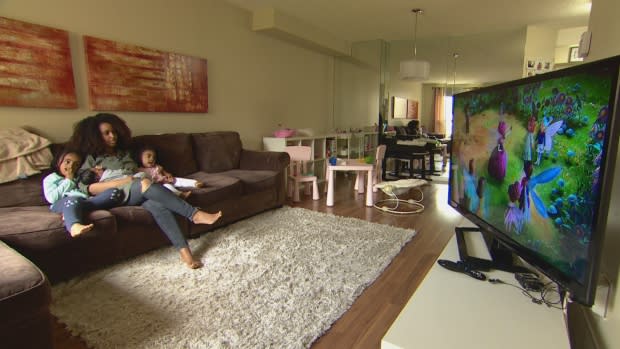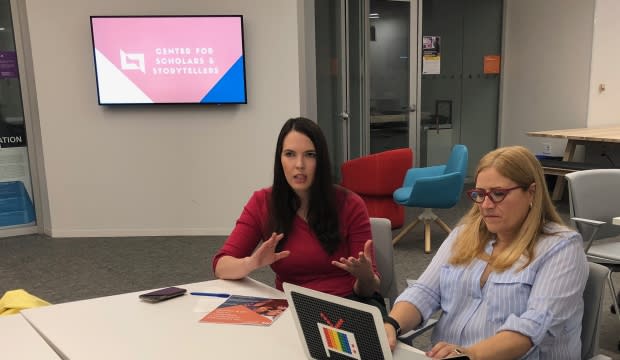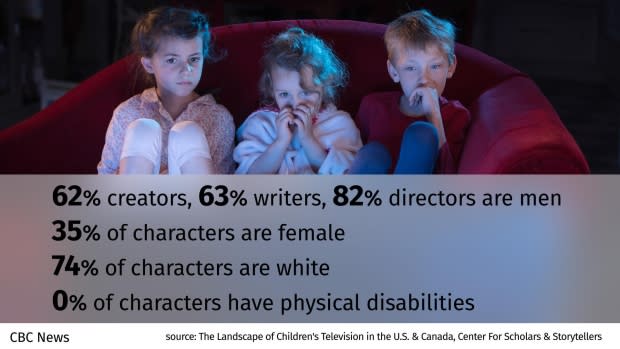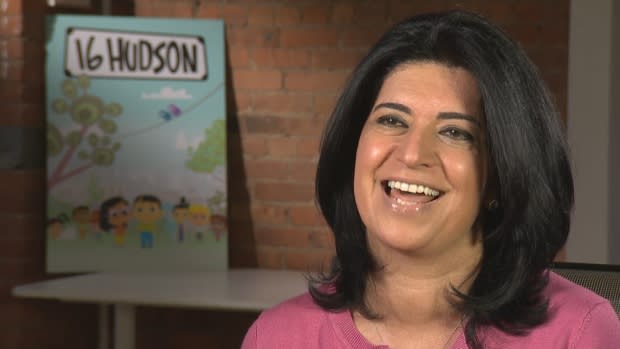Kids' TV lacks gender balance and diversity, new study suggests
Senait Litchmore pays attention to the shows her daughters enjoy, but she's been surprised by what they notice — such as the time her five-year-old declared Peppa Pig was white (the pig is pink in colour), or branded Paw Patrol "a boys' show" because, of all the main characters, only one is female.
While Litchmore merely saw shows populated by anthropomorphic pigs and puppies, her eldest was picking up on nuances her mother failed to see.
"Although they are animals [on Peppa Pig], she was still categorizing them as various races," said the Toronto-based therapist and mother of three.
"I didn't notice that there was only one female [main] character on [Paw Patrol]. I just thought it was cute — a bunch of puppies, great show — but it stood out to a three-year-old. That's fascinating."
As a result, Litchmore is considering ramping down their TV time.
"I can choose what literature they read, I can choose who they hang out with, where they go," she said.
"I can choose all these things, but I have limited control over what's on television. I don't want their hopes and dreams to be limited in an indirect way, based on what they see on television."
'We have not improved at all'
Litchmore's story wouldn't surprise Colleen Russo Johnson, the Canadian co-author of a new study of the children's television landscape. Part of a wider effort involving eight countries, the study prepared in April 2019 takes a deep dive into U.S. and Canadian TV programming for kids aged 12 and under that aired on traditional broadcasters in the fall of 2017.

In Canada, that amounted to nearly 600 shows seen on broadcasters like TVO, CBC, Treehouse, Disney Jr., Nickelodeon and PBS. Russo Johnson and Dafna Lemish, her co-author based at Rutgers University in New Jersey, compared the 2017 findings to a study with similar parameters conducted in 2007.
They found that, over those 10 years, the representation of female characters did not change, programming focused overwhelmingly on male characters, and it remained dominated by male creators behind the scenes.
In addition to lacking diversity in many forms, shows skewed toward fictional storytelling with animated (as opposed to live action), non-human characters.

"We have not improved at all," said Russo Johnson, who serves as co-director of the Center for Scholars and Storytellers at Ryerson University in Toronto. (The centre is also affiliated with the psychology department at the University of California, Los Angeles.)
"We are still at 35 per cent on-screen female representation, so that was really unfortunate to see."
The decline in live-action programs and human characters (in both live-action and animated shows) is troublesome, she said, because children learn "pro-social messages" better from people "rather than a talking animal."
Pro-social messages are those "messages of kindness, working together — a lot of the messages that are actually embedded in children's television. … It's learning a lot about how to get along and inclusivity," and similar topics, she said.
Colleen Russo Johnson explains what kids learn from TV
Russo Johnson was also disappointed by the lack of diversity in the 2017 programming.
"I'm not just referring to gender diversity or racial diversity," she said. "I'm talking economic diversity, body shape, neurodiversity, physical differences — all these things we are not currently seeing accurately represented on-screen."
Creating inclusive content
Alarm about how her culture was being depicted in media is what led Shabnam Rezaei from finance to children's programming.
After Sept. 11, 2001, the Iranian-Canadian was deeply affected by an increase in negative portrayals of Iranians. Then based in New York, she decided to create an online magazine highlighting Iranian culture, and eventually start her kids' content studio, Big Bad Boo.

"We're all people that are hyphenated Canadians, I like to say," Rezaei said. "All these hyphenated Canadians need to be represented in the media, and that's what we've aimed to do."
Two of her shows are the animated series 1001 Nights (translated into 15 languages and sold to broadcasters in 80 countries) and 16 Hudson, which is aimed at preschoolers.
Beyond telling stories about diverse communities, Rezaei also staffs her shows with people from those communities.
"I wanted the writers to write for these characters from real experiences, so that the episodes would resonate with kids," she said.
For 16 Hudson, which has characters of different ethnicities and family compositions, Rezaei opened up her writers' room to diverse candidates. They may have come in with less industry experience, but she wanted to "help them learn and come up with the show," as high-profile entertainment industry figures such as Ava DuVernay and Lena Waithe have done in the U.S.
Diverse crews have also proved valuable. In one 16 Hudson episode about the Lunar New Year, for example, a production coordinator of Chinese heritage suggested corrections to details in the background and to the foods depicted.
"If you have the right crew on board, you can not only tell stories that have never been told, but you can also be really authentic with your storytelling," said Rezaei, who challenges more industry colleagues to "put their money where their mouth is" by being more inclusive.
'We want all kids to see themselves'
When the creators of tween live-action show Detention Adventure were brainstorming for the series, they also took inspiration from their own lives.
The new CBC Gem show follows a trio of sixth-graders, plus the school bully, as they use science and problem-solving to search for a secret Alexander Graham Bell lab rumoured to exist under their school.
Not only are the characters racially diverse, Detention Adventure was envisioned from the start as female-led, according to showrunner Joe Kicak.
"I was raised by my sister and my mother, mostly — they were very strong women — and I wanted to portray that on camera," Kicak said.

During auditions, Kicak and co-writer Carmen Albano said they saw a diverse crowd of about 400 young actors.
"We want all kids to see themselves on TV," Albano said, adding that the four who were hired stood out for the strength of their acting ability, not just their diversity.
"It's important for us to show these kids are [the best for the roles]. That's why they're on the show."
Colleen Russo Johnson offers tips to parents navigating kids' TV content.
Russo Johnson says many creators of Canadian kids' programming have seen — and reacted to — her study.
"People have been extremely positive, but they've been very surprised by the findings," she said. "They were shocked to see that we haven't improved [since 2007]."
What's important, Johnson said, is that many creators have expressed a desire to improve the statistics.
"They have said things like, 'Well, now that I'm more aware, I can actually make some changes."
8 recommendations for content creators from study co-author Colleen Russo Johnson:
Pay attention to gender: "If it's a family of rabbits or a family of human characters, it doesn't matter, because we're still teaching the child viewer about what's normal and expected when it comes to gender breakdown. So it's really important that content creators are aware of this and make a conscious effort that no matter whether it's animal, robot, plant, object — as long as it's a character — that it's a 50-50 gender split."
Beware of stereotypes: "We saw that [female characters] were twice as likely to use magic to solve their problems, compared to males, and males more likely to use STEM skills ... as well as physical strength. That's problematic both for females, especially when we're trying to get more females into the science fields, but also for males, because males are more than just physical strength."
Introduce diversity: "[Creators] can make sure they're introducing more diverse characters. The fact of the matter is, it's not only the right thing to do for moral reasons, but it's good for business, as well. You should be reflecting the audience that you see, otherwise they won't want to watch your content."
Incorporate differently abled characters: "We didn't even have enough main characters with disabilities to register as a percentage in our sample. ... We need to see kids with disabilities, whether physical disabilities or neurodiversity, kids with autism, kids with dyslexia, kids with hearing impairments. It's really important that all these kids are incorporated as main characters ... and that they're not defined by their disability."
Depict different economic backgrounds: "Approximately 20 per cent of children are living at or below the poverty line. ... And yet what we've found is that only two per cent of characters were given what we deem to be lower-class financial economic situations. So we are not even close to hitting the mark when it comes to economic diversity."
Avoid tokenism: "This idea that people might be trying to check two boxes with one casting, or have one token female of colour in the writers' room ... we're suddenly asking this one female, for example, to not only speak for all females and show all types of females, but also now speak for what it's like to be a person of colour. That's an unfair pressure to put on one actor, one character, one writer."
Diversify behind-the-scenes: "Writers and creators are creating content and writing content to what they know and their experiences in life. ... What the data showed us is we are doing a horrible job right now when it comes to behind-the-scenes."


